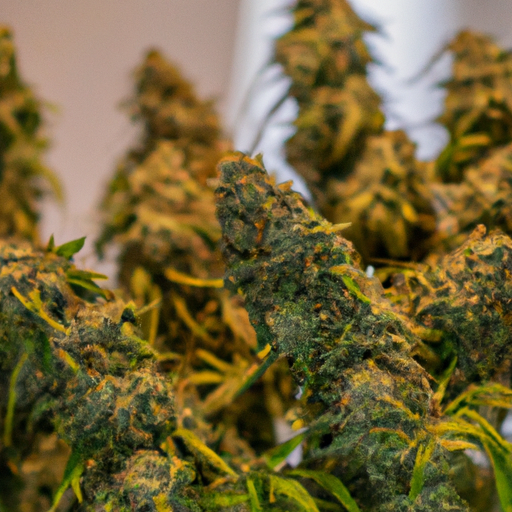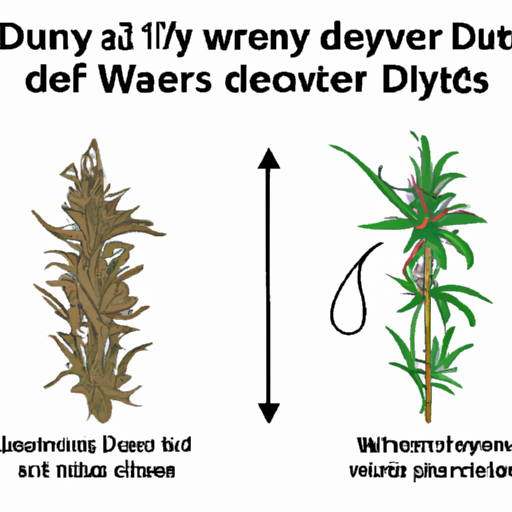This review delves into the art and science of trimming cannabis, exploring the tools and techniques employed by industry professionals. It provides a comprehensive overview of the subject, highlighting the importance of this process in enhancing the quality and value of the final product.
Why is Trimming Cannabis Important?
Trimming cannabis is a crucial step in the cultivation process that cannot be overlooked. This process involves removing unwanted leaves and excess material from the buds, resulting in a visually appealing and high-quality product. Trimming cannabis serves several important purposes. Firstly, it enhances the overall aesthetic appeal of the buds, making them more marketable and visually appealing to consumers. Additionally, trimming ensures that the buds are free from excess plant material, such as leaves and stems, which can negatively impact the taste and smoking experience.
Trimming also plays a significant role in improving the potency and quality of the final product. By removing unwanted parts, the trichomes, which contain the cannabinoids and terpenes responsible for the plant’s effects and aroma, are more concentrated. This results in a more potent and flavorful cannabis experience for consumers. Furthermore, trimming helps to improve the overall airflow around the buds, reducing the risk of mold and mildew development, which can significantly impact the quality and safety of the product.
Moreover, trimming cannabis is essential for compliance with regulatory standards. Many jurisdictions have specific requirements regarding the appearance and cleanliness of cannabis products, including the absence of excess leaves and stems. Failure to comply with these standards can result in legal issues and a negative reputation within the industry.
Overall, trimming cannabis is a vital step in the cultivation process that ensures the production of visually appealing, potent, and safe cannabis products. It enhances the aesthetic appeal, improves potency and quality, and ensures compliance with regulatory standards. By investing time and effort into mastering the art of cannabis trimming, cultivators can elevate their products and provide consumers with an exceptional cannabis experience.

1. Image of untrimmed cannabis buds illustrating the need for trimming
‘The right tools for the right job’: Essential Cannabis Trimming Tools
When it comes to trimming cannabis like a pro, having the right tools is crucial. These tools are specifically designed to make the trimming process more efficient, precise, and effective. With the right tools in hand, cultivators can achieve the desired results and produce high-quality buds.
 Trimming Scissors
Trimming Scissors
One of the most essential tools for cannabis trimming is a pair of trimming scissors. These scissors are specifically designed with sharp, narrow blades that allow for precise trimming of the buds. Look for scissors with a comfortable grip and a sharp, durable blade to ensure a comfortable and efficient trimming experience.

Trimming Shears:
In addition to trimming scissors, trimming shears are also commonly used in cannabis trimming. These shears have longer blades and are ideal for trimming larger leaves and stems. They are designed to provide a clean and precise cut, ensuring that unwanted material is removed without damaging the buds.
Trimming Machines:
For large-scale cannabis operations, trimming machines have become increasingly popular. These machines automate the trimming process, allowing for faster and more efficient trimming. They can handle a large volume of buds at once, saving time and labor. However, it’s important to note that trimming machines may not provide the same level of precision as manual trimming, and some cultivators prefer the hands-on approach for better control over the final product.
3. Techniques for Trimming: Wet vs Dry
When it comes to trimming cannabis, there are two primary techniques:
wet trimming and dry trimming. Each technique has its own advantages and considerations, and cultivators often have their preferences based on their desired outcome and workflow.
- Wet Trimming:
Wet trimming involves trimming the cannabis plant immediately after it is harvested and while it is still moist. This technique is preferred by some cultivators as it is believed to preserve the aroma and flavor of the buds. Wet trimming also allows for easier removal of excess leaves and stems due to their pliable nature. However, wet trimming can be more time-consuming and messy, as the plant material is wet and sticky, which can result in clumping and clogging of trimming tools. - Dry Trimming:
Dry trimming, on the other hand, involves allowing the harvested cannabis plant to dry before trimming. This technique is favored by many cultivators as it simplifies the trimming process. The dried plant material is less sticky, making it easier to handle, and the buds have a reduced risk of damage. Dry trimming also allows for a slower, more controlled trimming process, enabling cultivators to focus on the details and achieve a higher level of precision. However, dry trimming can result in a loss of terpenes and the potential for a less pronounced aroma and flavor profile. - 3. Hybrid Approach:
Some cultivators opt for a hybrid approach, combining elements of both wet and dry trimming techniques. They may choose to wet-trim the larger leaves and stems immediately after harvest while allowing the smaller sugar leaves and buds to dry before final trimming. This approach allows for easier removal of excess plant material while preserving the trichomes and maintaining the desired aroma and flavor.

3. Diagram showing the difference between wet and dry cannabis trimming techniques
4. Manual Trimming: A Labor of Love?
Manual trimming, often considered a labor-intensive process, is a true labor of love for many cannabis cultivators. This technique involves using hand-held trimming scissors or shears to meticulously trim the excess leaves and stems from the cannabis buds. While it may be time-consuming and physically demanding, manual trimming allows cultivators to have full control over the final product, ensuring the highest quality and appearance. The hands-on approach enables cultivators to carefully inspect each bud, removing any undesirable plant material and creating a visually appealing end product. Additionally, manual trimming allows for a personal touch, as cultivators can tailor the trimming process to their specific preferences and standards. This technique requires a keen eye for detail, patience, and a steady hand to ensure consistent and precise trimming. Moreover, manual trimming allows cultivators to establish a closer connection with the plants, gaining a deeper understanding of their characteristics and nuances. While manual trimming may not be the most efficient method, it offers a sense of craftsmanship and artistry that cannot be replicated by machines. It allows cultivators to truly express their passion and dedication to producing top-quality cannabis. However, it is important to note that manual trimming may not be suitable for large-scale operations due to the time and labor requirements. Despite its challenges, manual trimming remains a respected and cherished technique among cannabis cultivators who value the craftsmanship and attention to detail it brings to the trimming process.
5. Machine Trimming: Is Technology the Future of Cannabis Trimming?
As the cannabis industry continues to grow, so does the demand for efficient and cost-effective trimming methods. Machine trimming has emerged as a potential solution to meet these demands, offering increased productivity and consistency.
- 1. The Advantages of Machine Trimming:
One of the primary advantages of machine trimming is its ability to significantly reduce the time and labor required for trimming. With the use of automated machines, large quantities of cannabis can be processed in a fraction of the time it takes for manual trimming. This allows cultivators to streamline their operations and increase their overall productivity. Additionally, machine trimming can result in higher yields, as it is designed to efficiently remove excess leaves and stems, maximizing the usable portion of the plant. - 2. Consistency and Quality Control:
Machine trimming offers a level of consistency that can be difficult to achieve with manual trimming. These machines are calibrated to trim the cannabis buds to a specific length, ensuring uniformity in appearance. This consistency is not only visually appealing but can also be beneficial for packaging and marketing purposes. Moreover, machine trimming reduces the risk of human error, resulting in a more standardized and reliable end product. - 3. Challenges and Considerations:
While machine trimming has its advantages, there are some challenges and considerations to keep in mind. One of the key concerns is the potential for loss of trichomes, which are the resinous glands containing cannabinoids and terpenes. Machine trimming can be more aggressive than manual trimming, and this can lead to a higher risk of trichome damage or loss. Additionally, machines may not be as adept at identifying and removing unwanted plant material as human trimmers, which can result in a less refined final product.

‘Practice makes perfect’: Mastering Cannabis Trimming Techniques
Mastering cannabis trimming techniques requires dedication, patience, and a commitment to honing one’s skills. Like any craft, the art of trimming cannabis takes time to develop, but with practice, it can become second nature.
To begin, it is important to familiarize yourself with the different types of cannabis plants and their unique characteristics. Sativa, Indica, and hybrid strains may have distinct leaf structures and densities, requiring different trimming approaches. Understanding the plant’s natural growth patterns can help trimmers make more precise cuts and achieve desired results.
Sharp, high-quality trimming tools are essential for achieving clean and precise cuts. Trimmers should invest in a reliable pair of trimming shears or scissors that are specifically designed for trimming cannabis. Keeping the tools clean and well-maintained ensures optimal performance.
Developing a consistent and efficient hand motion is crucial for speed and accuracy. Trimmers often use a technique called “the pinch,” where they gently hold the stem between their thumb and forefinger while carefully removing excess leaves with the other hand. This method allows for precise control and minimizes the risk of damaging the buds.
Additionally, trichome preservation is a key consideration. Trichomes are the resinous glands that contain the valuable cannabinoids and terpenes responsible for the plant’s aroma and effects. Gentle handling and minimal contact with the trichomes during the trimming process help maintain their integrity and potency.
As with any skill, practice is paramount. Trimmers can start by working on small batches and gradually increase the quantity as their proficiency improves. Seeking feedback from experienced trimmers or attending workshops can provide valuable insights and techniques for continuous improvement.
Safety Measures: How to Trim Cannabis Safely and Efficiently
When it comes to trimming cannabis, safety should always be a top priority. Trimming can involve sharp tools and repetitive motions, making it important to take precautions to prevent accidents and injuries. Here are three key safety measures to consider:
- Personal Protective Equipment (PPE):
Wearing the appropriate PPE is crucial when trimming cannabis. Start by protecting your hands with gloves, preferably made of nitrile or another suitable material. Gloves not only protect against cuts and scrapes but also help maintain hygiene standards. Additionally, consider wearing safety glasses or goggles to shield your eyes from potential plant debris or flying trimmings. - Ergonomic Considerations:
Trimming cannabis can be a time-consuming task, often requiring long hours of repetitive motion. To prevent strain or injury, it is important to prioritize ergonomics. Ensure you have a comfortable and supportive chair or stool to sit on, allowing for proper posture and minimizing discomfort. Take regular breaks to stretch and rest your hands and arms. Investing in wrist supports or using ergonomic trimming tools with comfortable handles can also help reduce strain on your hands and wrists. - Proper Ventilation:
Trimming cannabis can release strong odors and fine plant particles into the air. It is crucial to work in a well-ventilated area to prevent the accumulation of potentially harmful fumes or dust. Consider setting up a ventilation system, such as an exhaust fan or air purifier, to maintain clean and fresh air. This is especially important if you are working in an indoor setting.

7. Infographic highlighting safety measures during cannabis trimming
Tools and Techniques for Trimming Cannabis:
| Tool | Use | Advantages | Disadvantages |
|---|---|---|---|
| Pruning Shears | Cutting stems and leaves | Precise cuts, control over size | Time-consuming |
| Electric Trimmers | Cutting leaves and buds | Fast, efficient | Damage to buds |
| Hand Trimmers | Gently removing fan leaves | Precise, gentle | Time-consuming |
| Vacuum Trimmers | Removing excess leaves | Fast, efficient | Damage to buds |
Trimming cannabis like a pro is an art that requires practice, patience, and knowledge. With the right tools and techniques, one can significantly enhance the quality, potency, and value of cannabis. Whether you’re a seasoned grower or a novice in the field, understanding these techniques can transform your cannabis cultivation journey.





